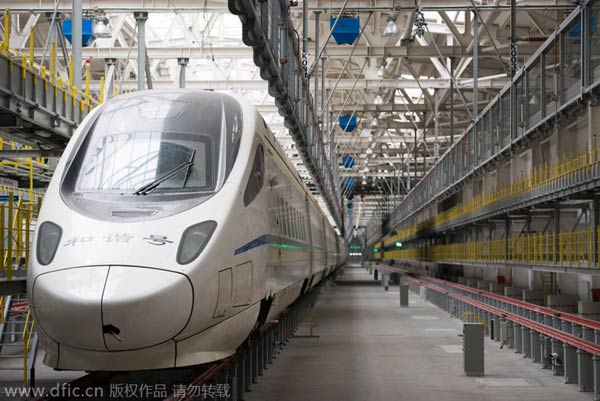A CRH (China Railway High-Speed) train is seen at a maintenance station for an overall system examination in Urumqi city, northwest Chinas Xinjiang Uygur autonomous region, June 3, 2014. [Photo/IC]

Pollution control, conservation of resources among the key points
China has released its first design specification standards for high-speed railways, which experts say will help improve safety and boost exports.
The standards, drawn up and published by the National Railway Administration, govern nearly 20 fields involved in the design and construction of lines for bullet trains running at 250 to 350 km per hour.
"These specifications are fundamental and important technical requirements," the railway administration said in a statement.
"They will provide a systematic technical foundation for the nation's development of its high-speed railway network and its efforts to export high-speed railway technologies and products."
The standards, which take effect on Feb 1, place the top priority on safety, stipulating that only multiple-unit trains, rather than traditional push-pull ones, can run on high-speed lines, the administration said.
Yang Hao, a professor at Beijing Jiaotong University who researches rail transportation management, said China had planned to adapt these traditional trains to high-speed lines to maximize the lines' efficiency, but the results of tests and trial runs were unsatisfactory.
"The standards treat safety as the top principle, ruling out the possibility of freight trains using high-speed lines, which can be dedicated to passenger transportation,"Yang said.
Designers and contractors have been asked to adopt a host of safety measures listed in the standards, which are stronger than the ones currently in use.
Railway construction firms have also been asked to reduce pollution and to save resources.
The standards state that designers must consider factors including the environment and transportation requirements when planning newlines.
Li Hongchang, an associate professor of transportation economics at Beijing Jiaotong University, said a set of standards is essential for supervision of high-speed rail projects.
"Without specific standards, it would be very easy for local governments and contractors to circumvent the central government's supervision," he said.
Yang said publication of the standards will also substantially help China's high-speed railway exports.
"They (foreign countries) can now check our standards and measures and know we are serious about safety, environmental protection and technological innovation," he said. "But it will take some time for foreign nations to accept and recognize our standards."
China has seen rapid development of high-speed railways construction. By the end of 2013, it had a network stretching for more than 10,000 km, the most in the world and larger than the entire European Union network, the World Bank said in a report in July.
Premier Li Keqiang has told government leaders, railway planners and company executives in Asia, Africa, Australia and Europe that China's high-speed railway technologies are safe, reliable and economically competitive. Largely due to his promotional efforts, Chinese enterprises have been selected to build several high-speed lines overseas.
zhaolei@chinadaily.com.cn
